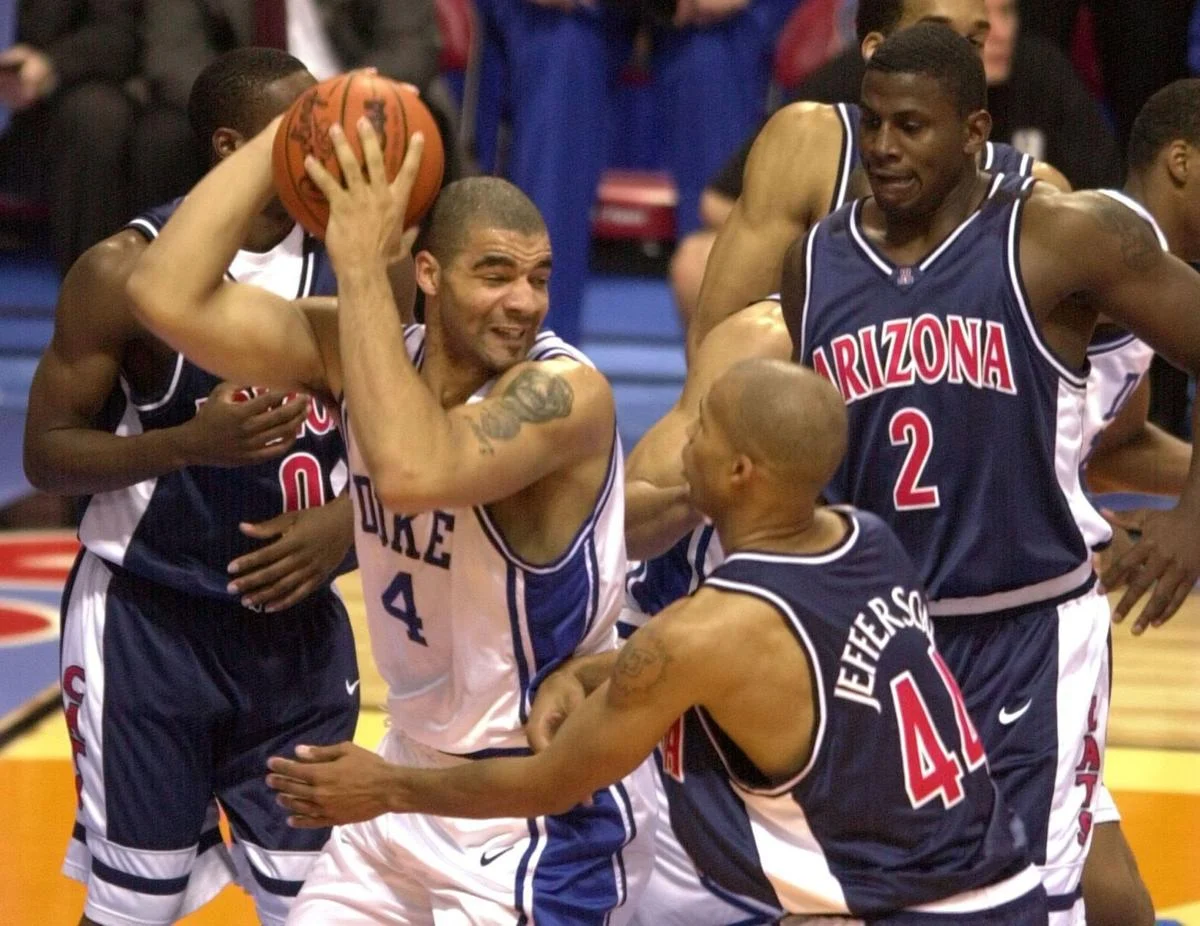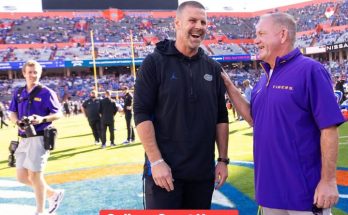How the Arizona-Duke Men’s Basketball Rivalry Was Born | Greg Hansen
College basketball rivalries are an integral part of the sport’s rich history. From North Carolina versus Duke to Kentucky versus Louisville, rivalries form over decades of competitive battles, legendary performances, and moments that leave fans and players with an indelible mark. One rivalry that has gained increasing attention in recent years—though it may not yet carry the same historical weight as the traditional blueblood showdowns—is the Arizona-Duke men’s basketball rivalry. While these two powerhouse programs have had relatively few meetings on the court compared to some of the most storied rivalries in the NCAA, the encounters they have had have been intense, high-profile, and full of drama. The story of how this rivalry came to be and why it resonates so strongly within college basketball lore is one that combines history, culture, and individual personalities.
In this article, we’ll delve into the origins of the Arizona-Duke rivalry, tracing back to the formative years of both programs, the pivotal matchups that ignited the competitive fire between them, and how key figures in both teams’ histories helped fuel the growing animosity. Additionally, we will examine the reasons behind the heightened intensity of their matchups and how fans, coaches, and players have embraced this rivalry.
Arizona Basketball: The Rise of a National Power
Before Arizona could stake its claim as one of the premier basketball programs in the nation, the Wildcats had to endure years of building and crafting a competitive foundation. The Arizona Wildcats were not always a dominant force in college basketball. However, the program’s rise began in the 1980s under head coach Lute Olson, who took over the reins in 1983. Olson’s commitment to defensive prowess, efficient offense, and recruiting high-caliber talent quickly transformed Arizona into a national contender.
Olson’s program reached new heights with the arrival of high-profile recruits like Sean Elliott, a player who would later be inducted into the Hall of Fame and who was instrumental in taking the Wildcats to national prominence. Arizona captured its first major conference title in 1986 and began to show its potential on the national stage. By the early 1990s, Arizona was consistently competing for Pac-10 titles and was becoming a fixture in the NCAA Tournament.
The Wildcats’ peak came in 1997, when they won their first NCAA championship. Behind a stellar lineup featuring players like Mike Bibby, Jason Terry, and Miles Simon, Arizona captured the national title by defeating the University of Kentucky in one of the most thrilling championship games in NCAA history. That victory cemented Arizona as a basketball powerhouse, and their success throughout the late ‘90s and early 2000s only further solidified the Wildcats as a premier program.
Duke Basketball: The Legacy of Coach K
Duke, on the other hand, had established its own dominance much earlier under legendary coach Mike Krzyzewski, or “Coach K.” Duke had built its reputation as a tough, disciplined, and incredibly skilled program. Under Coach K, the Blue Devils became one of the most consistent and successful teams in the history of NCAA basketball.
Duke’s success began in the 1980s, but it was in the early 1990s that the Blue Devils really hit their stride. The program was consistently competing for national championships, with the 1991 and 1992 titles solidifying Duke’s reputation as a top-tier program. Players like Christian Laettner, Grant Hill, and Bobby Hurley became household names during this period, and Duke built a dynasty, one that seemed to have few equals in college basketball. With Coach K leading the charge, Duke was not just a basketball team but a brand—a standard for excellence that defined college hoops for a generation.
Duke’s unparalleled success and consistency over the next several decades—coupled with Coach K’s ability to continue bringing in elite talent—kept the program near the top of the college basketball world. As a result, Duke became synonymous with winning and was often the team to beat come tournament time. The Blue Devils’ victory in the 2015 national title game, their fifth under Coach K, capped off a truly incredible run for the program.
The Birth of the Rivalry
While Arizona and Duke had become elite programs in their own right, the actual rivalry between them didn’t take shape until the late 1990s and early 2000s. What started as a couple of high-profile matchups between the two teams quickly escalated into a rivalry characterized by intense competition, differing basketball styles, and a growing level of animosity.
The catalyst for the rivalry can be traced back to a key event: the 1997 NCAA Tournament. The Arizona Wildcats, having already captured a national title earlier that season, were poised to make another deep run in the tournament. In that year’s Final Four, they faced off against a Duke team that had a potent mix of talent, including future NBA stars like Trajan Langdon and Cherokee Parks.
Arizona’s victory in that game, while significant, marked just the beginning of what would become an intense series of matchups between these two programs. The 1997 game itself set the tone for future encounters, as both teams displayed not only their elite skill but also their ability to rise to the occasion in high-pressure situations. Arizona’s win gave them the opportunity to clinch a national championship, which they did by defeating the University of Kentucky in one of the most memorable games in NCAA history.
While the rivalry wasn’t immediately cemented after this meeting, the foundation for competitive animosity had been laid. Arizona’s confidence in their ability to beat Duke in the clutch proved to be a point of pride for the Wildcats, and this only intensified when the teams met again in future matchups.
Key Moments in the Rivalry
- The 2001 Elite Eight: Perhaps one of the most iconic matchups between Arizona and Duke came in the 2001 Elite Eight, a game that remains a highlight of both programs’ histories. In this matchup, Duke was heavily favored to win the national championship that year. Arizona, however, played with a chip on its shoulder and staged an incredible comeback in the second half. The game came down to the wire, with Arizona prevailing 85-81 in a dramatic finish. This victory was a huge statement for the Wildcats, proving that they could overcome even the toughest of competition, including a team that had become a symbol of college basketball excellence.
- The 2010 Sweet Sixteen: Another critical moment in the rivalry occurred in the 2010 Sweet Sixteen. This was a highly anticipated game, as Arizona was led by head coach Sean Miller, a former Duke assistant, and featured a team with multiple NBA-caliber players. Meanwhile, Duke was on a mission to win its fourth national championship under Coach K. The Blue Devils ultimately defeated Arizona in a tightly contested game, continuing their path toward the 2010 national title. While Duke’s win here didn’t ignite a full-scale rivalry like some others, it deepened the relationship between the two programs, as Arizona had yet to get the upper hand over Coach K’s squad.
- The 2015-2016 Matchups: While not part of the NCAA Tournament, the matchups during the 2015-2016 season brought the two teams back into the national spotlight. Both teams had reloaded with high-level talent, and Arizona’s desire to prove itself against a program with as much history and success as Duke drove the intensity. With both teams being consistently ranked near the top, these regular-season games played an important role in building the animosity and competition between the two.
The Importance of Coaching Styles and Philosophies
A significant aspect of the Arizona-Duke rivalry lies in the contrasting coaching styles of Lute Olson and Mike Krzyzewski. Coach Olson was known for his free-flowing offense, reliance on sharp perimeter shooting, and his ability to create matchup problems for opponents with his up-tempo style. Olson also recruited players who fit well within this system, creating a fast-paced, high-scoring brand of basketball that was fun to watch and difficult for opponents to handle.
In contrast, Coach K’s teams at Duke were renowned for their emphasis on discipline, defense, and fundamentally sound basketball. While Duke was capable of playing up-tempo at times, the Blue Devils’ hallmark was their suffocating defense, smart ball movement, and ability to execute in clutch situations. Coach K’s focus on team-first mentality, with less reliance on individual talent than Arizona, created a stark contrast in approach. The juxtaposition of Arizona’s speed and offensive firepower against Duke’s defensive expertise made each matchup between the two teams a fascinating clash of philosophies.
The Future of the Rivalry
Though the Arizona-Duke rivalry may not yet rival the intensity of long-established college basketball rivalries, its potential to grow remains high. Both programs remain competitive year after year, with blue-chip recruits flocking to both schools, and the fan bases behind them continue to grow and stir the narrative surrounding each encounter. While these two teams have met less frequently in the NCAA Tournament, each time they do face off, it’s a must-watch matchup for college basketball fans.
Additionally, with Arizona and Duke both continuing to recruit top talent, including high-profile prospects, the rivalry seems poised to intensify in the coming years. As long as both programs remain at the top of their respective conferences, fans can expect the drama, excitement, and competitive tension to remain a central part of college basketball’s future.



